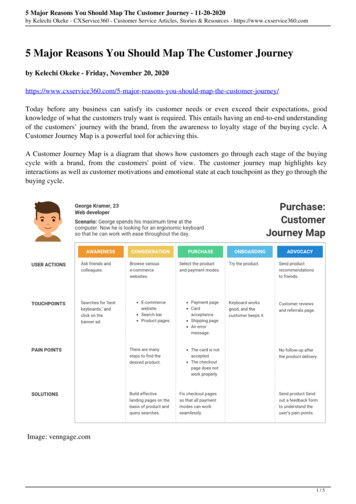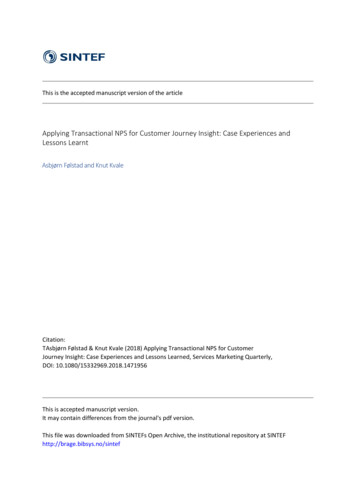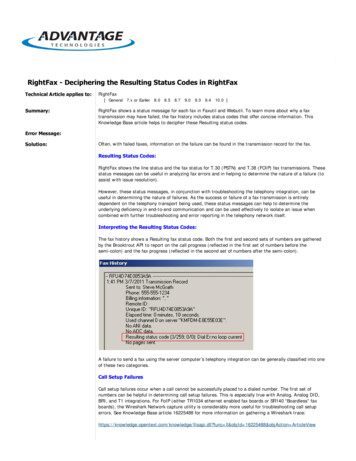
Transcription
Deciphering the Customer’sBuying JourneyCustomer Insights Driven Store RetailingResearch Partner
IntroductionRetailers must focus their store transformation efforts on strengthening operational and unified commerce capabilities(e.g. in-stock, store fulfillment of online orders, enterprise inventory visibility, omnichannel transaction & ordermanagement) and related data insights. This in turn improves their understanding of customer buying journeys orpath-to-purchase decisions1. However, two-thirds of retailers only possess intermediate capabilities to capture anduse store buyer journey insights2 from different in-store devices, products and systems which impedes their abilityto understand such journeys and deliver great customer experience. With connected devices and sensors collecting,presenting and using real-time information in meaningful, actionable ways, retailers can have all the information andinsights they seek readily available. Retailers need to have in-depth knowledge of customers’ buying behavior acrossdevices, stores, products and shopping sites in order to improve customer experience through personalization.Retailers are not Fully Aware of a Customer’s Store JourneyA customer’s shopping journey in the store does not always start when he/she enters the four walls but when he/she starts browsing the products,pricing and in-store product availability on various digital channels andDigital channels influence almostdevices. Digital channels influence almost 48% of in-store sales3, so48% of in-store salesretailers must keep themselves fully apprised of customer’s brick andclick behavior before, during and after the buying experience.1Defined as the series of decisions that a customer makes in purchasing a product or service from a retailer2EKN Digital & Omnichannel Survey, 20163Deloitte Navigating the New Digital Divide Report
As bricks and clicks continue to converge, stores are experiencing new operational and customer experiencechallenges. Though customers have been quick to adopt the digital revolution, retailers are still struggling tocatch up with the omnichannel shopper in the store. Lack of customer insights is the top pain point relatedto store operations4, due to which 1 in 2 retailers are unable to predict customer traffic. Further, retailers failto identify half of their in-store customers in terms of key demographics and psychographics5. This impairstheir ability to tailor stores’ varied operational capabilities in the areas of inventory availability, dynamic pricing,assortment-mix, promotions and staffing with customer engagement needs.Lack of customer insightsis the top pain pointrelated to storeoperations1 in 2retailers are unable topredict customer traffic4EKN Merchandising Study, 20155EKN Customer Context Power - A Success Imperative for Every Retailer, 2015
Though integrating store systems and digital processes is difficult, retailers have prioritized investments forintegrating customer insights with store operations. 1 in 2retailers rank customerinsights as the top area forinvestment for improvingmerchandising across channels6Effective use of customer insightscan results in8.3% improvement inaverage basket size7.4% improvement incustomer’s wallet share8Use of customer insights is not limited to back-end operations but also useful in interaction between customersand store associates. Retailers consider improving customer engagement as the top driver of their employeeengagement strategy7. With knowledge of customer insights (such as customer traffic, product preferences,shopping history and buying habits), store associates can offer a continuity that is severely lacking in mostretailers’ customer experience. They can personalize recommendations and build stronger relationships withtheir most loyal customers.6EKN Merchandising Study, 20157EKN Associate Empowerment Study, 20158EKN Analytics in Retail, 2015
Retailers Have Too Much Information, But Lack Actionable InsightsOver the past few years, retailers have started collecting data from various customer touchpoints in the storebesides traditional point-of-sale (POS) systems. Due to lack of analytics maturity, retailers rely on historical POStransaction data when making business decisions which tend to misalign with customers’ wants & desires.While touchpoints like kiosk, mobile, Wi-Fi, beacons and eCommerce give a lot of information to retailers, manyare still struggling to make sense out of the unstructured data related to store customer prospective productpurchase affinity, preferences and buyer journeys.Top challenges which retailers face due to failure to leverage analytics in store decisionsInability to integrate data fromInability to deliver insights to themultiple sourcesright resource at the right time
Currently, there are 4 types of data that support the store initiatives: Social media data: This refers to all forms of data captured on social media platforms. This generallyrelates to the characteristics of an individual and his demographics, opinions, attitude and preferencesthat are tracked using product reviews, loyalty information and other types of identifiable customer data. Transactional data: These are primarily originating from the point of commerce such as POS, kiosks,endless aisle, etc. Traditionally, this transaction log data has been conveniently available to the retailersfor their analytics engine. Operational data: The data originating from the corebusiness operations such as inventory management,merchandising planning and execution, pricing, andpromotions forms the basis of the operational data to buildthe process maturity aspect in the data ecosystem.Social ta Textual data: This is the most complex and the mostchallenging piece of data that needs to be tapped byretailers. Such data is unstructured in composition andusually originates from customer survey data, customerfeedback data, word of mouth reviews, etc.
Effective utilization of unstructured data into actionable customer insights can help retailers in improvingstore performance in various areas such as dynamic pricing management, promotion management, inventoryplanning, order fulfillment, customer traffic visibility, among others. For instance, 1 in 2 retailers contend thatthe use of store-based machine, sensor and web log data can help them improve inventory availability and 4in 10 retailers say that such data can help them design and send location-based promotions9. The benefits ofhaving actionable insights are encouraging retailers to invest in various technologies that support collection andprovision of insights from such data to store teams. The retailers’ rated top ten business/customer intelligenceareas needed to best support customer service and operational performance in the store are highlighted in theillustration on next page.10Value Derived by Using Store-based Machine, Sensor & Web Log Data9, 1053%52%38%32%30%ImproveOfferDesign and ecutioncustomersEKN Tyco Immersive Retail Experience Survey, 2016
From an operational perspective, inventory accuracy and quick insight into item by location are keys to efficientomnichannel fulfillment and ensuring customer satisfaction. Such improvements improve store inventory searchcapabilities and real-time agile response leading to more reliable product availability information for customers.Inventory accuracy also positively impacts store pick accuracy, customer inventory reserve, customer inventorypickup and other last mile fulfillment methods.Top Ten Business/Customer Intelligence tore spaceor floor planLosspreventionCustomertraffic
Customer insights are not only vital for having one view of customer across channels but also, effective use ofcustomer insights across the enterprise operations can help to improve sales by 8.3%.8.3%incrementalrevenue 83 Mnimprovement in salesfor 1 billion retailer 11ConclusionWith customers integrating more and more with digital devices and channels into their lives, retailers will need towork towards achieving deeper insights into customer’s buying journey in the store. With their limited budgetsand other operational execution challenges in the adoption of new technologies, retailers will be facing difficultchoices. Successful retailers will be the ones who are able to integrate one view of customer & one view ofproduct aggregated from various digital and physical channels. Such a strategy can assist them in selectingcritical technological investments which will have the maximum impact on key store performance KPIs.11EKN Analytics in Retail Study, 2015
RecommendationsSTShort Term (0-6 months)MTMedium Term (6-12 months)LTLong Term (1-2 years)Store CultureSTMTCombine customers’ in-store location and behavior intelligence with store operations programs thatoptimize inventory, pricing, replenishment, staffing or promotions, to drive meaningful and contextualcustomer interaction.Customer Experience/JourneysSTCreate store and digital buyer journey profiles. Map such profiles to price, promotion and merchandiseaffinity for each customer segment and provide access to such insights to HQ and store managers.MTDo Proof-of-Concepts (POC) to test whether proximity-based technologies like Bluetooth beacons, RFID,Wi-Fi, IR sensors and ambient noise have a play in your store. Focus the POCs on context-based promotions,inventory optimization, dynamic pricing, associate engagement, among other operational improvements.
Performance ManagementSTUse customer insights from foot traffic, inventory movement/flow, merchandise displays in addition tosales trends to identify why and where in the journey of customers does the store process workflowbreak-down and outline actions to address each gap.MTDefine and adopt a mix of metrics/KPIs that align well with your organization’s customer engagementstrategy and measure the efficiency of the strategy.Knowledge or Data ManagementSTLeverage customer and product/inventory data from ‘all’ channels to enhance store localization. Sharecustomer and inventory data before, during and after purchase with stores to improve customerengagement.MTForm a think-tank that provides strategic direction and mapping of all customer engagement andexperience initiatives (both business and technology-related). The think-tank must include eCommerce, stores, omnichannel, customer research, merchandising, IT,supply chain and marketing stakeholders.
The team should also be accountable for laying out the journey for omnichannel customer satisfaction,future of retailing and channel transformation objectives that foster long-term customer value andoperations.MTIntroduce process and tool based internal and external collaboration between merchandising, marketing,IT, sourcing, product development and supply chain to create a knowledge center of free and openinformation exchange - a type of intranet to flag issues and create new ideas.Enabling technologiesSTElevate change management resolution or the ability to manage new technology or program introductionas part of every clustered or integrated omnichannel systems transformation approach involving a singleor multiple point applications or a platform.STAssign a task force that combines both data-rich and sensor-based technologies and align business changemanagement best practices with the roll out of such technologies.STMTAs part of the transformation approach include unified inventory, order management, customerinformation and consistent pricing and promotions.MTEvaluate whether your current store network and wireless infrastructure can handle the technology rollouts and pilots that you have planned over the next 24 months. If not, look at strategic upgrades ofcapacity in the medium-term even as you plan for a broader strategic overhaul.
Our research agenda is developed using inputs from the end user community and the end user community extensively reviews the research before it is published. This ensures that we inject a healthy dose of pragmatisminto the research and recommendations. This includes input of what research topics to pursue, incorporatingheavy practitioner input – via interviews etc., and ensuring that the blend of research takeaways are orientedtowards a real-world, practical application of insights with community sign-off. For more information, visit www.eknresearch.com. Email us at EKNinfo@edgellmail.comTyco Retail Solutions is a leading provider of integrated retail performance and security solutions, deployedtoday at more than 80 percent of the world’s top 200 retailers. Customers range from single-store boutiquesto global retail enterprises. Operating in more than 70 countries worldwide, Tyco Retail Solutions provides retailers with real-time visibility to their inventory and assets to improve operations, optimize profitability, andcreate memorable shopper experiences.The Tyco Retail Solutions portfolio for retailers is sold direct through Tyco businesses and authorized businesspartners around the world. For more information, please visit TycoRetailSolutions.com or follow us on LinkedIn, Twitter, and our YouTube channel.Disclaimer: EKN does not make any warranties, express or implied, including, without limitation, those of merchantability and fitness for a particularpurpose. The information and opinions in research reports constitute judgments as at the date indicated and are subject to change withoutnotice. The information provided is not intended as financial or investment advice and should not be relied upon as such. The information isnot a substitute for independent professional advice before making any investment decisions.Copyright 2016 EKNRegistered Office: 4 Middlebury Blvd. Randolph, NJ 07869Ph: (973) 607 1300
A customer's shopping journey in the store does not always start when he/ . Form a think-tank that provides strategic direction and mapping of all customer engagement and experience initiatives (both business and technology-related). The think-tank must include eCommerce, stores, omnichannel, customer research, merchandising, IT, .










